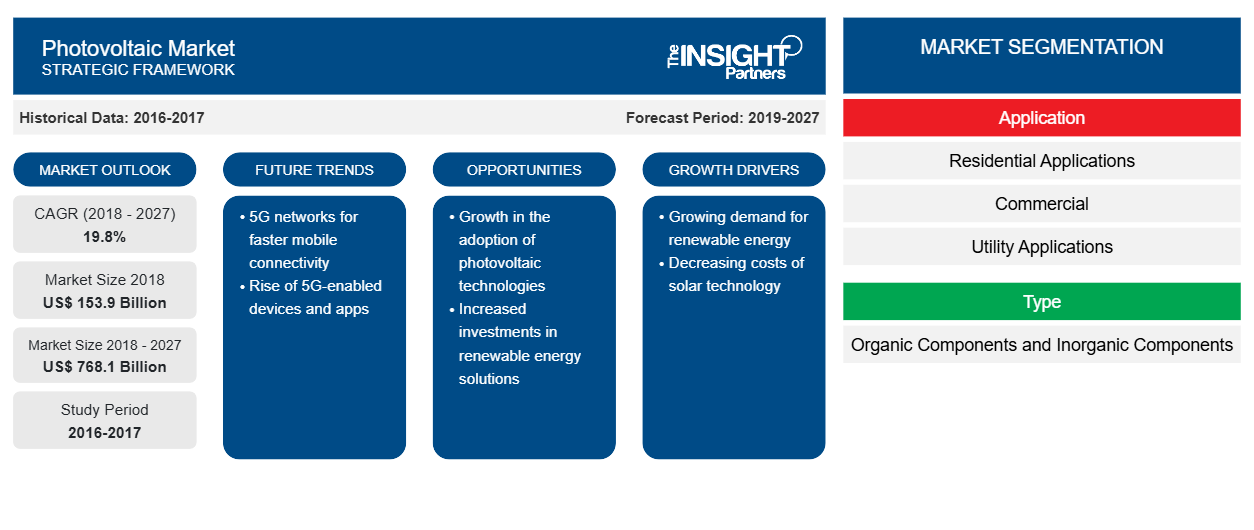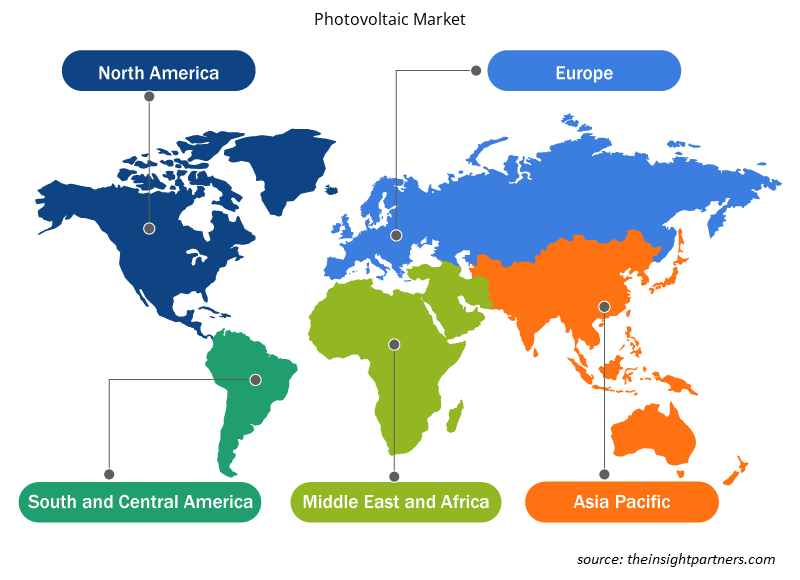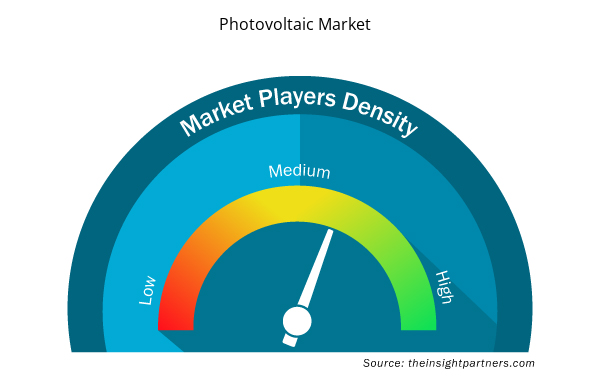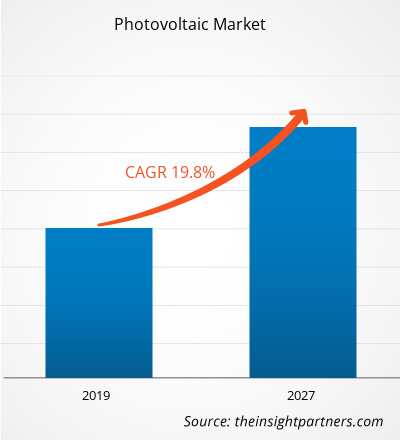The photovoltaic market is expected to grow from US$ 153.9 billion in 2018 to US$ 768.1 billion by 2027 at a CAGR of 19.8% between 2019 and 2027.
In the wake of technological development and focus toward a growing trend of solar PV technology, the German and Spanish governments have established robust policy frameworks such as clear national targets, attractive incentives to promote consumption, and integrated plans to boost technological development and PV technology adoption in solar energy and drives the photovoltaic market growth. In APAC, several initiatives have been taken by governments to minimize the cost of the overall set-up to maximize the far-reaching benefits of an off-grid option in rural electrification, along with uplifting the focus toward sustainable environmental conditions. Moreover, several countries, such as China, have established policies to enhance the production level of photovoltaic solar power energy. Thus, above-mentioned factors are contributing toward the growth of the photovoltaic market.
Photovoltaic (PV) energy is growing at a rapid pace by contributing a significant part in the energy balance of the economy’s power systems. These systems have established to be a mature technology utilized for mainstream electricity generation and drive the photovoltaic market growth. However, solar-powered PV systems generate electricity in excess. Power providers across the world provide net metering, which is defined as an arrangement where the excess electricity produced by grid-connected renewable energy systems returns to the electricity meter. This avoids wastage and improves energy distribution as and when needed. PV systems using grid technology account for about 99% of the installed capacity in comparison with standalone systems, which require batteries. Battery-less grid-connected PV is considered to be a cost-effective solution and needs less maintenance which increases the adoption of PV-based products and thus drives the photovoltaic market share.
Moreover, for people switching over to solar panels, grid PV systems are considered to be a cost-effective option to meet their entire electrical needs. Also, the installation of standalone systems is quite a tedious task and requires more capital and space than that of PV grid systems. Thus, the rise in the adoption of PV-grid system will further drive the photovoltaic market growth. Further, with increasing focus toward the use of renewable energy along with a trend toward energy conservation, grid-connected PV systems prove to be an economically viable option. However, its applicability is quite limited at the moment and might increase in the forthcoming years.
Customize This Report To Suit Your Requirement
You will get customization on any report - free of charge - including parts of this report, or country-level analysis, Excel Data pack, as well as avail great offers and discounts for start-ups & universities
Photovoltaic Market: Strategic Insights

- Get Top Key Market Trends of this report.This FREE sample will include data analysis, ranging from market trends to estimates and forecasts.
Customize This Report To Suit Your Requirement
You will get customization on any report - free of charge - including parts of this report, or country-level analysis, Excel Data pack, as well as avail great offers and discounts for start-ups & universities
Photovoltaic Market: Strategic Insights

- Get Top Key Market Trends of this report.This FREE sample will include data analysis, ranging from market trends to estimates and forecasts.
Customize This Report To Suit Your Requirement
You will get customization on any report - free of charge - including parts of this report, or country-level analysis, Excel Data pack, as well as avail great offers and discounts for start-ups & universities
Photovoltaic Market: Strategic Insights

- Get Top Key Market Trends of this report.This FREE sample will include data analysis, ranging from market trends to estimates and forecasts.
Photovoltaic Market Insights
Increasing Use of Photovoltaic Paints for Tapping Solar Energy
The volatility in the prices of crude oil, environmental concerns related to hydropower, and risk associated with nuclear radiation have shifted the burden of meeting energy demands on solar energy. The advancements in technology, focus on the reduction of installation costs, and rapid utilization of photovoltaic technology in residential applications are among the factors that are redefining the use of photovoltaic technology. In the era of increased usage of solar energy, the introduction of solar paints has become a remarkable achievement. Solar paints, or popularly known as photovoltaic paints, can be applied to any surface to trap energy from the sun and convert it into electricity. The components of the paint are combined with billions of pieces of light-sensitive material suspended in it, which could help in transforming a typical paint into super-powered energy-capturing paint. The use of photovoltaic paint can effectively lower down the dependency on metal and a combination p-n junction diode principle/thermoelectric effect to produce electrical energy from solar exposure. Thus, this will lead to a rise in the adoption of solar energy and eventually propel the photovoltaic market growth. Companies such as Onyx Solar Group LLC are aiming toward the development of technology by focusing on R&D activities and collaborating with the institutes to develop photovoltaic paint and thus drive the photovoltaic market growth. Although solar paints or photovoltaic paint technology are currently at the stage of infancy, it is likely to gain traction in the near future. With the progression and advancement of the solar industry, solar paint has an excellent opportunity to become a reasonable option. Thus, above-mentioned factors are creating an opportunity for the photovoltaic market.
Photovoltaic Market Regional Insights
Photovoltaic Market Regional Insights
The regional trends and factors influencing the Photovoltaic Market throughout the forecast period have been thoroughly explained by the analysts at Insight Partners. This section also discusses Photovoltaic Market segments and geography across North America, Europe, Asia Pacific, Middle East and Africa, and South and Central America.

- Get the Regional Specific Data for Photovoltaic Market
Photovoltaic Market Report Scope
| Report Attribute | Details |
|---|---|
| Market size in 2018 | US$ 153.9 Billion |
| Market Size by 2027 | US$ 768.1 Billion |
| Global CAGR (2018 - 2027) | 19.8% |
| Historical Data | 2016-2017 |
| Forecast period | 2019-2027 |
| Segments Covered |
By Application
|
| Regions and Countries Covered | North America
|
| Market leaders and key company profiles |
Photovoltaic Market Players Density: Understanding Its Impact on Business Dynamics
The Photovoltaic Market market is growing rapidly, driven by increasing end-user demand due to factors such as evolving consumer preferences, technological advancements, and greater awareness of the product's benefits. As demand rises, businesses are expanding their offerings, innovating to meet consumer needs, and capitalizing on emerging trends, which further fuels market growth.
Market players density refers to the distribution of firms or companies operating within a particular market or industry. It indicates how many competitors (market players) are present in a given market space relative to its size or total market value.
Major Companies operating in the Photovoltaic Market are:
- Mitsubishi Electric Corporation
- Panasonic Corporation
- Kaneka Corporation
- KYOCERA Corporation
- Sharp Corporation
Disclaimer: The companies listed above are not ranked in any particular order.

- Get the Photovoltaic Market top key players overview
Component-Based Market Insights
Photovoltaic cells consist of two or more thin layers of semi-conducting material. The most commonly used material in the photovoltaic cell is silicon. The semiconductor cells are exposed to light to generate electrical charges, and this can be conducted by metal contacts as direct current (DC) and thus increasing adoption of PV cells will rise the global photovoltaic market size in the forecast period.
Players operating in the photovoltaic market adopt strategies such as mergers, acquisitions, and market initiatives to maintain their positions in the photovoltaic market. A few developments by key players are listed below:
- In 2021, Royal Dutch Shell PLC debuted its 25-megawatt Qabas solar facility. The project is made up of over 88,000 solar modules, is located on a 50-hectare location in northern Oman's Sohar Free Zone. It aids in the reduction of around 25,000 metric tons of CO2 emissions per year.
- In 2021, the 300 MW Sakaka PV IPP, the country's first utility-scale renewable energy project, was inaugurated by ACWA Power at a cost of SAR 1.2 billion. ACWA Power was awarded the project at a world-record tariff of US$ 2.3417 cents per kWh (8.781 halalas per kWh).
- Historical Analysis (2 Years), Base Year, Forecast (7 Years) with CAGR
- PEST and SWOT Analysis
- Market Size Value / Volume - Global, Regional, Country
- Industry and Competitive Landscape
- Excel Dataset



Report Coverage
Revenue forecast, Company Analysis, Industry landscape, Growth factors, and Trends

Segment Covered
Application, Type and Component

Regional Scope
North America, Europe, Asia Pacific, Middle East & Africa, South & Central America

Country Scope
US, Canada, Mexico, UK, Germany, Spain, Italy, France, India, China, Japan, South Korea, Australia, UAE, Saudi Arabia, South Africa, Brazil, Argentina
Frequently Asked Questions
Renewable energy is regarded as a clean form of energy obtained from natural sources, which can be continuously replenished. Energy derived from renewable sources such as sunlight, wind, tides, and geothermal heat are sustainable and cost-effective. With the increase in population coupled with a rise in industrialization and economic development, the energy requirements have grown consistently, which is posing a burden upon natural resources. For instance, in the US, about 29% of global warming emissions are contributed to the electricity sector. Such emissions are resulted from the utilization of fossil fuels such as coal and natural gas. Over-exploitation and depletion of natural resources along with environmental degradation have led to a shift over renewable forms of energy. The demand for electricity is associated with social and economic development that generates a requirement to shift to renewables in order to tackle climate change and promote sustainability of the environment while meeting energy demands of future generations. Renewable forms of energy generate little or no global warming emissions.
The leading type of photovoltaic type is inorganic components that has noted to account a CAGR of 22.3%. Organic components or solar cells are made of thin films of organic semiconducting materials so as to convert solar energy into electrical energy. A typical organic components device consists of one or more photoactive materials between two electrodes. A primary advantage of organic components technology over inorganic components is its ability to be applied in a large area and flexible solar modules.
The Asia Pacific region led the photovoltaic market with a market share of 52.13%in 2018. Solar energy has brought significant changes to energy usage pattern, from being an alternative source of energy to becoming a primary source of energy for power generation. It is quite evitable with the growing research and development activities focused on the increased production of solar energy, coupled with positive government initiatives and decreasing costs of photovoltaic equipment, in the Asian countries. Further, the diversification in the use of solar energy generation techniques by harnessing various technologies such as PV cell, thermal heating, and concentrated solar power technology is also leading to the growth of this industry.
Trends and growth analysis reports related to Electronics and Semiconductor : READ MORE..
The List of Companies
- Mitsubishi Electric Corporation
- Panasonic Corporation
- Kaneka Corporation
- KYOCERA Corporation
- Sharp Corporation
- JA Solar Co.,Ltd.
- Renesola Co. Ltd
- Trina Solar
- Jinko Solar
- Shunfeng International Clean Energy Co., Ltd.

 Get Free Sample For
Get Free Sample For